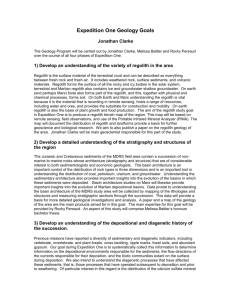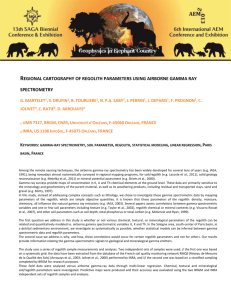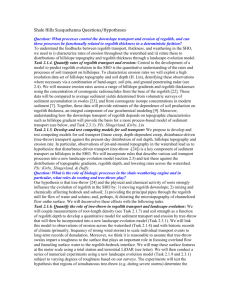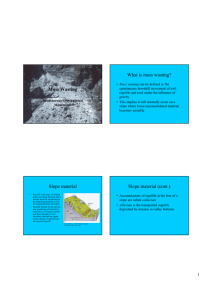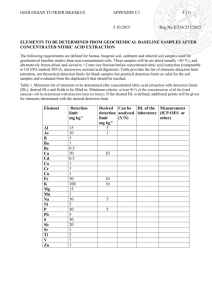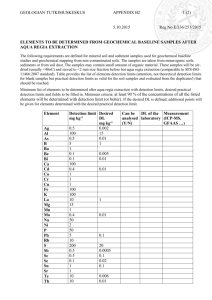Geochemical exploration in regolith- dominated terrains
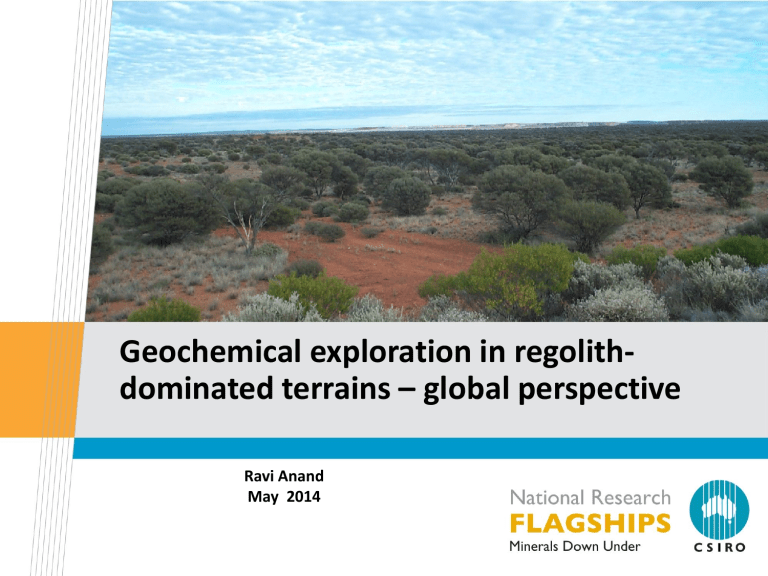
Geochemical exploration in regolithdominated terrains – global perspective
Ravi Anand
May 2014
Acknowledgements
•
Numerous mining companies
•
CSIRO/CRC LEME/MDU
•
AMIRA
Why regolith research for mineral exploration
Transported cover
In situ regolith
Regolith masks mineral deposits. BUT
Weathering produces many secondary deposits: Al, Nb, Ni, Co, Au, Mn, Fe, P, Li, U
Subtle dispersion patterns in regolith; important geochemical sampling medium
Mineral industry in Australia (and world wide) is vitally concerned with locating new deposits under cover.
This need for new mineral discoveries has been the driving force behind regolith research in Australia.
Needs of the mineral industry
• What useful information can be obtained from the regolith?
• How can we distinguish between residual and transported regolith?
• What is the geochemical/mineralogical ‘fingerprint’ of a concealed ore deposit in deeply weathered terrain? How reliable is this? What media should be sampled?
• Do ore deposits, buried under transported overburden have a surface or near-surface geochemical expression?
• Can we distinguish between null and negative result?
• How can we predict what sample media works where and why?
Impact: Discovery of Bronzewing gold deposit by buried lateritic residuum sampling
Distribution of regolith and present climatic zones
Deeply weathered profiles, ferruginous or bauxitic towards the surface are widespread
Commonly overlain by transported cover
Regionally continuous over large areas
The regolith has been forming continuously for over 100 my
Continue to evolve under savanna, rainforest and arid climates and a variety of landscape processes
Modification of regolith by climatic conditions: we need to understand these variations
Savanna, West Africa Rainforest, Latosol, Amazon
Different climatic conditions produce modifications to pre existing profiles
Modifications give rise
to new geochemical
parameters that will affect
general procedures for geochemical exploration
in various climatic regimes.
Claudio Porto
Adriana Horbe
Climate conditions influence the distribution of metals (e.g,
Au) and hence sample media for exploration
Compiled from several sources
Development of complex weathering profiles by landscape processes and multiple weathering
Weathered profiles have residual and transported components
Several phases of Fe, Ca, Si and Al
minerals-each with total or partial resetting of geochemistry
Systematic approach to identifying regolith
materials
Link evolution of regolith to
geochemical processes and sampling strategies
Ferricrete (transported)
Lateritic residuum (residual)
Mapping regolith and landforms
Complete profiles
(R)
Truncated
(E)
Depositional
(D)
Arid
Inverted landscape
Savanna
Rainforest Costa, 1993
Adriana Horbe
Factual regolith-landform map
Interpretative regolith-landform map
(Sampling strategy map)
Regime Sample
Relict
Lateritic duricrust and/or gravel
Ferruginous lag & saprolite
Erosional
Depositional
Soil – note colluvial & aeolian input)
Establish depth of overburden nature of residual profile:-
Buried lateritic residuum preferred if present
If cover <2m thick: soil
If cover >2m thick: Vegetation
Termite mounds
Calcrete
Gases
Interface
Saprolite
groundwater
termite mounds
Dispersion model, Erosional regime (Truncated profile)
Regolith profile: Erosional regime
Residual soil
Saprolite
Anomaly in soil and lag due to:
Bioturbation, Residual and Chemical dispersion
Dispersion halo is narrow (50-100 m)
Sample media:
Soil
Lag
Saprolite
Dispersion model: Relict regime (Complete profile preserved)
Lateritic residuum (Residual nodules and pisoliths)
Dispersion halo is much larger than
ore deposit itself
Residual, biological and mechanical dispersion
Goethitic cortices are important carrier of metals
Large proportion of Au is biogenic
Cu in cortices
Biogenic Au
Buried lateritic residuum below cover is effective sample media
Anand and Smith
The Challenge - Seeing through transported cover in a cost effective manner
Australia Brazil
Paleochannel clays, sand and gravel
Belterra clay
Mottled clays
Mineralisation
Surface techniques have tremendous advantages for mineral exploration
Partial extractions had limited success
Poor understanding of vertical metal migration processes
Adriana Horbe
Understanding mechanisms that can form anomalies through transported cover in various climatic zones
Dispersion mechanism: Electrochemical dispersion
Cross Lake VMS deposit, northern Ontario, Canada
Glaciated terrain
High water table
Transported overburden
(30-50 m) overlying sulphide mineralisation
0-10 cm soil
10-20 cm
VMS mineralisation
Cameron et al. (2004)
Dispersion mechanism: Seismic pumping in neotectonic active areas
Spence Cu deposit, Northern Chile
Vertical fracture in saline soil
Over 250 m of gravel overlying mineralisation
Earthquake prone area
Movement of metals along vertical fractures
Cameron et al 2004; Kelley et al, (2006)
Dispersion mechanism: Vegetation
Metal uptake by deep tap root system and laterals
Mapping of ore-related elements by PIXE and Synchrotron in leaves and roots from various deposits
Cu-Zn-Ag
Au
Vegetation can form anomaly through 30 m transported cover, Freddo Au deposit, Yilgarn Craton
Biogenic particulate Au in Eucalyptus leaves: varies from 2 to 68 ppb in a single tree
45
5
2
68 4
6
1
2
7
2
Organic
Gold particles (red) within
leaves
Dispersion mechanism: Termites
Moolart Well Au deposit, Yilgarn Craton 5-15 m of transported cover
Response in termite mounds but not in soil using aqua regia
( Aqua regia ) or partial extractions
Response in termite mounds
in shallow cover only
Jaguar
VMS deposit:
Termite mandibles
Mn n
M n
Br n
Why soil anomaly not always formed despite anomaly in vegetation, termite mounds or gas collectors?
Normal environment Dust storm
Erosion by sheetwash, flooding
and wind
Erosion > Input = No anomaly in soil
Dispersion mechanism: Gaseous
North Miitel Ni deposit,
Yilgran Craton
Ni on activated carbon
15 m transported cover
Highly saline water
Anomaly only in gas collectors but not in soil or vegetation
Mineralised
Microbial processes are important in anomaly formation: example from VMS (Cu-Zn-Ag) deposit
Background
% similarity
Bands associated with ‘mineralisation’ were DNA sequenced
Generated a library of ~100 DNA sequences:
1) Target for exploration
2) Provide insights into microbial species associated with mineral interaction in regolith
Pit experiments: Anomalies can form quite quickly
Water extraction
Pit Experiment
Six pits were dug
Ores (VMS-Cu-Zn-Ag, Au) and salts buried under stagnant and nonstagnant environments
Elevated concentrations of Zn, Cu and Au in soil after 7 months in stagnant environments.
Seasonal variations in metal migration
Column experiments
Ore was placed on tray
Summary of dispersion mechanisms at sites investigated in Australia (AMIRA P778)
Conclusions
• Understanding terrain evolution is of more than academic interest.
• Select geochemical methodologies to suit the regolith terrain and interpret the results appropriately
• Lateritic residuum (relict regime) and soil and lag are effective sample media in erosional regime
• In depositional regime, more than one mechanism of vertical metal migration is likely to operate in a given setting.
• Electrochemical dispersion, seismic pumping, vegetation, termites, gaseous and capillary are important mechanisms for vertical transport of metals.
• Geochemical anomalies can form quite quickly.
• Research is required in Brazilian and African environments.
AMIRA/ADIMB P1123: Geochemical exploration in regolith-dominated terrains – A global perspective
• MINERALS DOWN UNDER FLAGSHIP
Key objectives: proposed project (AMIRA /ADIMB 1123):
• Develop consistent and uniform system for identifying, describing and naming of regolith materials.
• Determine the processes of formation of regolith materials (regolith mapping) and metal dispersion in various climatic regimes.
• Determine the suitability of regolith materials as geochemical sample media in various climatic regimes
• Investigate the effect of provenance and properties of transported overburden and soil, on metal migration.
• Design pit experiments to verify the existence of specific metal migration mechanisms.
• Develop geochemical dispersion models and guidelines
• Prepare an atlas of various regolith types
• Translate research results into more cost-effective mineral exploration
Benefits to sponsors
• Participation in collaborative research with significant funding leverage
• Access to extensive experience and knowledge of world class regolith team
• New/improved cost-effective and practical exploration methods for exploring relict, erosional and depositional environments.
• Advanced characterisation of materials
• Guidelines for how, where and why to use regolith materials
• Better distinction between the negative and null result
• Training and workshops
